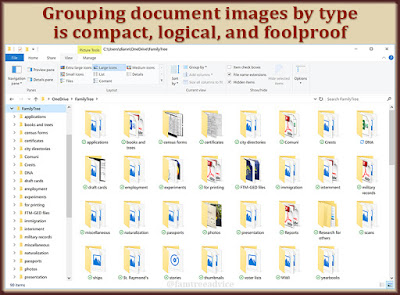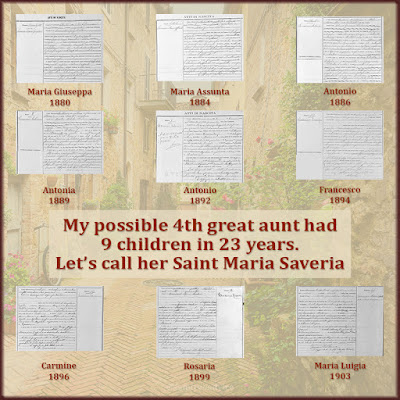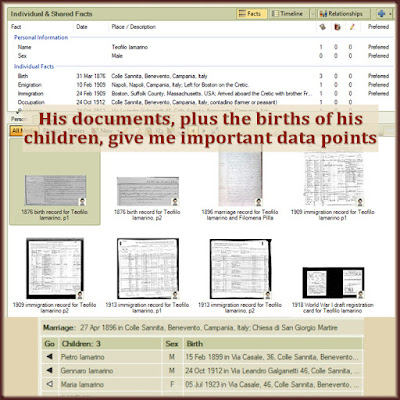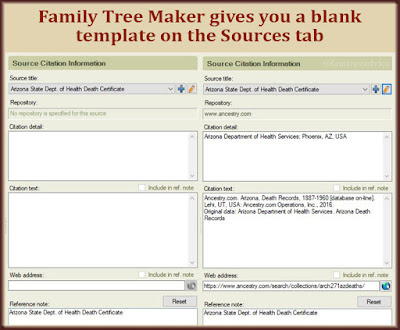A hint is only a suggestion. It isn't how you build your family tree.
I rarely look at hints for my family tree.
That's so me, of course. Not trusting anyone to do the job the way I want it done. I know which facts I'm missing. I'd rather search for them myself, thank you.
If you look at hints, and other people's family trees, how do you decide which facts to accept and which to ignore? How do you know that hint belongs in your family tree?
First of all, don't take anything for granted. Carelessly accepting a hint could add a branch to your family tree that has no relationship to you at all.
It's your job to evaluate the hint. These 3 basic rules will help you swat away the hints that are no good for your tree.
 |
| Follow these 3 basic rules to figure out if a hint is worthless. |
1. Does the Birth Year Make Sense?
I have a family in my tree that must be related to me. But I haven't found the proof. They came from my great grandparents' tiny hometown in Italy. The patriarch, Angelo, settled in a small Pennsylvania town with my cousin. Angelo has the same last name as that cousin's grandmother—my 2nd great grandmother.
I've been collecting a decent amount of documents for this family. I have Italian birth records, ship manifests, and U.S. censuses.
This Pennsylvania family does belong to a person I found who has them in his family tree.
But he made a big mistake with them. Angelo, the patriarch of the family, was born in 1849 and married in 1878. He and his wife Teresa had children in:
That's all fine. But this person gave Angelo 2 more children by another mother. They were born in 1881 and 1899. Compare those years to the list above.
Is it logical that Angelo married in Teresa 1878, had a baby in 1879, then had a baby with an unnamed woman in 1881? Then he went back to his wife Teresa and had kids in 1882, 1884, 1885, and 1890? And he returned to the unnamed woman to have a baby in 1899?
 |
| Those hints aren't as smart as you are. You can make a timeline. |
No. It is not logical. When I checked my own family tree for these 1881 and 1899 babies, I saw the problem.
Their father was not Angelo. He was Michelangelo. Michelangelo was Angelo's brother! His wife was Marianna. The 2 babies' birth records say their parents were Michelangelo and Marianna. Not Angelo and Teresa.
But let's assume this person didn't see those babies' birth records. Maybe he figured Angelo was a nickname for Michelangelo. That's not uncommon.
But a timeline of all the children should have told him these 2 were not Angelo's children by another woman.
Their birth years did not make sense for Angelo. A timeline would show that.
Pay attention to the birth year when you review a hint.
2. Does the Location Fit Your Family Tree?
Someone added my great grandfather Giovanni to her tree. He does not belong there. She added him and some of the documents I attached to him:
- His 1850 birth record from the town of Baselice, province of Benevento, Italy
- His 1881 marriage record to my great grandmother Marianna in Baselice
- His 1942 death record from Baselice that shows he's the widow of Marianna
This person made my Giovanni the father of a man with a different last name. From a different region of Italy.
That's not you.
You wouldn't take a man whose documents show he was born, married, had 5 children, and died in one part of the country, and make him the patriarch of a family from a different region. You wouldn't make him the father of a man (whose birth year you don't even know) who has a different last name.
You know how families worked in the 1800s.
Pay attention to the location.
3. Do the Family Members Work for Your Tree?
I had a hint for a woman in my tree named Irene. I knew very little about her. She's the mother of my 2nd cousin's husband, and I have this in-law policy.
If you're an in-law who hasn't asked me to research your family, I'm only recording facts about your parents. Not your siblings. Not your grandparents.
I was open to finding birth and death facts for Irene. I decided to look at the hint so I could tell you about it.
The hint was a link to the Find A Grave website where I saw Irene's obituary. The basic facts seemed right. But I wasn't willing to accept these facts yet. Not until I saw the proof in the obituary:
- her husband's name
- her maiden name
- my 2nd cousin and her husband's names
All the names were a perfect fit. Only then was I willing to record her birth and death dates in my family tree.
Pay attention to the names of the family members.
We all make mistakes in our family tree from time to time. We make typos, click the wrong thing, or go too far on a hunch. But there's no excuse for ignoring glaring mismatches in dates, places, and names.
Now that you know what to look for—and what to look out for—you can handle your hints like a pro.























